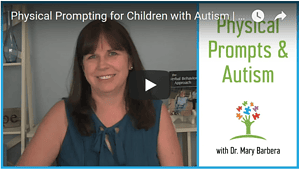Kids with autism often require a lot of physical prompting, especially when they are learning new tasks. But in my two decades in the autism world, I’ve seen a lot of physical prompting that would definitely be considered physical restraint and a few instances where some would consider it even abusive. Today we’re going to talk about physical prompting and the ethical issues that are involved, and when a physical prompt becomes a physical restraint.
A few weeks ago, I covered a related ethical issue of not programming for a whole child across all environments but today I want to talk specifically about an ethical issue of overusing physical prompting. Each week, I provide you with some of my ideas about turning autism around, so if you haven’t subscribed to my YouTube channel, you can do that now.
What is prompting, specifically a physical prompt?
In short, a physical prompt is any form of physically guiding or touching to help a toddler (most commonly) use a target behavior or skill.
Several years ago, I saw Dr. Vincent Carbone speak and he told a great story about a whale at Sea World jumping through a hoop. Somebody said to the trainer, well what happens if the whale doesn’t jump through the hoop? Obviously you can’t physically prompt the whale. The trainer’s response was, you have to make darn sure that the whale does not get the fish, which is the reinforcement.
I think it’s pretty clear in animal training, especially with large animals like whales, that there’s no physical prompting involved. But even with other animals such as a bird, you wouldn’t grab a bird’s beak to touch things to give the response. You would use shaping and chaining and extinction and other proven behavioral procedures.
Yet what I have seen over the years is an over-reliance on physical prompting and too much physical prompting, especially with kids with moderate/severe autism. As a child gets older and larger in size, physical prompting can become very dangerous.
When a physical prompt becomes a physical restraint
Today, I want to give you a few things to think about to avoid physical prompting and some ideas for what you can use instead. Many years ago when I first became a behavior analyst, I learned that if you are prompting a child to go to the bathroom and the child resists in any way and provides equal but opposite pressure back, that is actually considered a physical restraint. For many of you, this may be the first time you’re hearing this. Most times when people think of restraints, they’re actually thinking of mechanical restraints like a harness when a child sits in a bus or even a seatbelt to a booster seat is a mechanical restraint.
Physical restraints are when equal but opposite pressure. Even carrying a screaming toddler from one activity to another, ushering a child who’s fighting you and resisting to the bathroom, is a physical restraint. In the United States, in public schools, restraint, either mechanical or physical, is both illegal and presents ethical issues.
Of course at times, physical restraint and mechanical restraints are necessary. So a physical restraint might be necessary if a child is trying to run into a street or trying to throw a chair through a window. Obviously you’re going to get the child, grab them, do whatever it takes, grab the chair, to prevent injury of the child or others.
Attend a FREE Workshop!
But if you’re using physical prompting that’s crossing over to restraint on a daily or weekly basis, you need to really evaluate what to do instead because it is not legal, at least in public school autism classrooms. It could be in the IEP in the crisis plan for some kids, but you really need to, even if you’re using it in a crisis situation, you really need to then evaluate with the IEP team and make a plan to avoid this in the future.
A step towards better ethical decision making
So what can you do instead? Well first off, whenever you have any kind of problem behaviors or over-reliance on physical prompting, a full assessment is the best thing to start with. You need to assess not only just in that instance why the child might be pulling back or resistant. Say it’s a resistance to going to the bathroom, it’s not just looking at the bathroom issues, it’s also looking at language issues and behavior issues and all kinds of issues which is evaluating the whole child and what they need.
After a full assessment, you’d want to make a plan and then you’d want to put interventions in place that involve manding or requesting as the center of your program. You also want to keep learning fun and as easy as possible with 80% easy responses and 20% hard responses. Just all kinds of things, preventative strategies to help you avoid the use of physical restraints.
So in summary, whether you’re a parent or a professional, you need to be aware that a physical prompt oftentimes leads to physical restraint. When that happens, you need to look at ways to prevent that. If you can consult with a behavior analyst, if you aren’t consulting with one already, that’s always a great idea.
There are ways to assess and treat these problem behaviors so the child can have success, there’s dignity for the child, and that you’re in compliance, both ethically and legally.
For more information about a new four-hour ethical interview series that I recently conducted, you can visit marybarbera.com/ethics. If you want to learn more about programming for early and intermediate learners, I welcome you to sign up for my free online workshop at marybarbera.com/intermediateworkshop. I’d love it if you’d leave me a comment, share this video, or subscribe to my YouTube channel for more autism videos. And I’ll see you here next week.
Attend a FREE Workshop!







